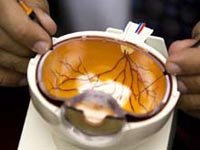Experimental Gene Eye Therapy Passed
The experimental gene therapy to correct an inherited vision defect, described Sunday in the journal Lancet, worked.

12 people with the condition known as Leber’s congenital amaurosis had a gene injected into one eye. All of the patients improved. The success of the experiment is a major boost for the field of gene therapy, which began 20 years ago and has had few clear successes in that time, said Ronald Crystal, a gene therapy researcher who wasn’t involved in the study.
A number of companies are developing gene therapies and 320 trials are under way or cleared to begin by U.S. regulators, said Karen Riley, a U.S. Food and Drug Administration spokeswoman. Genzyme Corp. of Cambridge, Massachusetts, will begin a human trial using gene therapy next year to treat macular degeneration, the leading form of age-related vision loss, said John Lacey, a Genzyme spokesman, in a telephone interview yesterday.
About 2,000 people in the U.S. have Leber’s and five children are born with the condition each year, according to researchers at Children’s Hospital of Philadelphia, where the study was conducted.
Leber’s causes impaired vision from birth as a result of defects in one of several genes. The patients in this study had mutations disabling a gene called RPE65 that produces a protein essential to vision, said Katherine High, a pediatrician and gene therapy researcher at the University of Pennsylvania.
Gene therapy has had a difficult history, with its most troubled chapter occurring at the University of Pennsylvania in 1999, when 18-year-old Jesse Gelsinger died within hours of being injected. The therapy, which used a different gene-bearing virus than the one Corey and his fellow subjects got, sparked a massive immune response, killing Gelsinger.
The current study drew extra scrutiny because of the school’s previous experience, said Jean Bennett, the study’s senior author.
In the study, four children and eight adults had the gene injected into one eye. That allows researchers to compare changes in the two eyes and leaves one protected if something goes wrong.
Patients improved on standard vision tests such as reading eye charts and their pupils had a much greater response when light was shined in their eyes, the doctor said.
“The best results were in the youngest patients who had more cells still present.”
None of the patients suffered serious adverse events. Some had minor immune reactions after the injections that disappeared within days.
The results help demonstrate the potential of gene therapy, said Cornell’s Crystal, who last year showed that gene therapy may help patients with a rare brain disorder.
“This is one of several examples where the field has been able to demonstrate that gene therapy can be effective,” he said. “That was the promise of gene therapy when it was first developing in the late 1980s. Now 20 years on, we’re seeing the fruits of all the hard work.”
Bloomberg has contributed to the report.
Subscribe to Pravda.Ru Telegram channel, Facebook, RSS!


